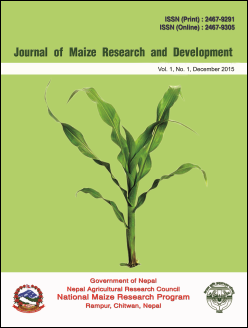Technology adoption analysis of improved maize technology in western hills of Nepal
DOI:
https://doi.org/10.3126/jmrd.v1i1.14252Keywords:
Maize, adoption, improved variety, respondentsAbstract
The survey was carried out in two districts namely Palpa and Baglung to determine the current level of adoption of improved maize production practices. This study identifies the technology adoption extent and pattern of improved maize technologies in Western Hills of Nepal. In each of these districts, two village development committees (V.D.Cs) were surveyed. Deurali and Khasyouli V.D.C from Palpa and Kudule and Malika V.D.C from Baglung Districts were selected. Structured Questionnaire were administered to 30 randomly selected households in each VDC. Altogether 120 Households were surveyed. The degree of adoption was measured on the seed rate, adoption of improved varieties, application of Nitrogenous, Phosphatic and Potassium fertilizer, Weeding and method of planting. The adoption index was used to determine the adoption level of the respondents. There seems to be a gap between the recommended practice and current level of practice at the farmers level in some of the factors like Nitrogenous, Phosphorus and Potassium fertilizers, method of planting .The study revealed that majority farmers belonged to high adoption category (57%) followed by medium adoption category (54%) and low adoption category (9%). The Technology Adoption Index (TAI) was found 63%. In nutshell there is still large scope for yield improvement of the maize in the study area by adopting improved maize varieties.
Journal of Maize Research and Development (2015) 1(1):146-152




